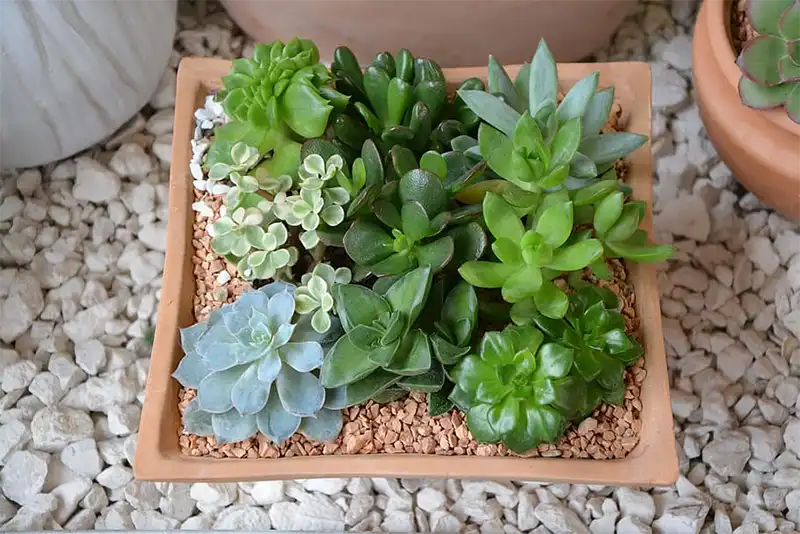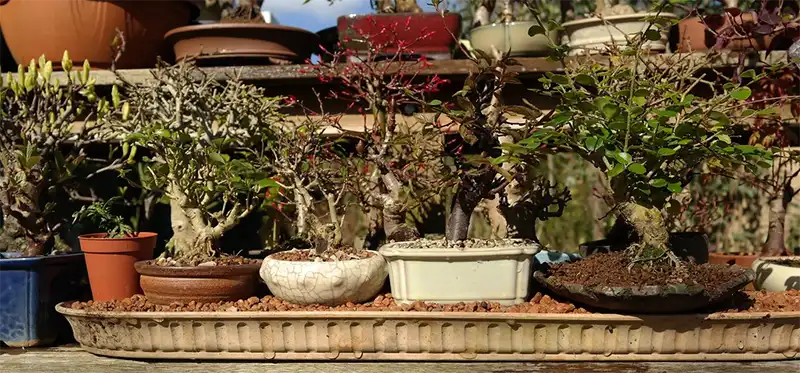What is a Bonsai Humidity Tray?
If you’ve ever dealt with spraying or misting your small tree, you may have wondered if you should buy a bonsai humidity tray. They don’t only serve to keep any of the drained water, but also in supplying the foliage with moisture in the air.
Do you need a bonsai humidity tray, and how do you use it? These are a few of the questions we’ll be answering in this article.
Image courtesy of 4.0 International
Table of Contents
Does A Bonsai Need A Humidity Tray?
One of the main concerns when it comes to bonsai tree care is watering and drainage. You need to ensure that it receives enough water, but it should pass through and not remain in the soil. You don’t want root rot to occur and cause damage to your tree.
We have a detailed bonsai tree care guide with all the relevant information. Check the guide out here!

Another concern is the surface on which you place the pot. You could cause irreparable damage to the material, whether it’s wood, metal, or plastic. So, the bonsai humidity tray protects it to prolong the lifespan. However, you can create a system whereby the one container drips down to a bonsai underneath if you have several layers or shelves.
So whether your bonsai needs a humidity tray is up to you. You’ll need to assess the needs of your tree and check if the platform you have it on can support wetness dripping onto it. You may also want the bonsai to drink from the tray when it’s incredibly thirsty.
Why Do Bonsai Need A Humidity Tray?
Another aspect of caring for a bonsai tree is ensuring that you have enough humidity for the foliage. When the air is dry, there’s more transpiration, and the bonsai may drink less water than it actually needs. While you can certainly mist the leaves, it will only increase the air’s moisture for 30 seconds after you stop.
For a better solution, you can place the humidity tray under the pot and fill it with water. On hot days, the sun evaporates the liquid, which then passes up into the air. It provides a more optimal solution for ensuring you have sufficient moisture.
You can also use the humidity tray to see how thirsty your bonsai is. After you supply a drop of water, check how quickly the roots absorb it into the soil. When it stops, and you have a layer of liquid remaining, then it’s had enough to drink.
How Do You Use A Bonsai Humidity Tray?
Using your bonsai humidity tray is easy, and you can place more than one upon each other with different sizes to create various levels of humidity. It’s better if you place decorative rocks on the tray to aid the evaporation process, which increases when the stones heat up from the sun.
You’ll need to ensure that you fill the tray daily so that there’s always enough moisture, especially in summer. When winter arrives, you still need to supply humidity, but you can slow down on watering the soil. The bonsai will only drink when it needs to.
Choosing The Right Humidity Tray
There are many styles of bonsai humidity trays on the market. For example, you’ll find shallow rectangular dishes or ones with meshes over. Some are round with deeper sides, while you can also buy humidity domes for seed trays. The type you’ll purchase depends on the stage of your bonsai and how large it is.
You should also take the shape and dimensions into consideration. Your best bet is to use the same shape as the bonsai pot or foliage for symmetry. You want it large enough that it can cover all the leaves on either side, ensuring that all of them can make use of the extra moisture.
Finally, take a look at the material. We know that plastic is the cheapest, but they don’t last as long as other materials, and they also break easily. You’ll also need to see if the depth is enough to cover how thirsty your species might get in the summer, taking into consideration the need to add decorative rocks.
What Is A Wet Pebble Tray?
A wet pebble tray is a fancy name for a bonsai humidity tray, but it also differs by using stones that are slighter larger than the decorative rocks. You can easily create your own one at home instead of buying the entire package, which is useful if you have some trays lying around.
Here’s how you can make your own wet pebble tray:
- Use a shallow tray that matches the shape of your bonsai container and foliage
- Find any pebbles or rocks that are suitable for the tray’s size
- Fill the tray with water, but don’t let it pass over the top of the rocks if you want to prevent the soil from remaining wet
- Check the tray daily to see if it needs some refilling.

Are Humidifiers Good For Bonsai?
If you want to take away the hassle of refilling the humidity tray every day, you can opt for an indoor humidifier. It provides moisture in the air mechanically, and there are different types you can try. There’s usually a water tank that you would need to refill, but it takes longer to empty than the humidity tray.
Another benefit of a humidifier is that you can use it for more than one bonsai in the room, while the humidity tray only covers a single tree. However, you’ll need to check that it doesn’t introduce harmful chemicals into the air. Also, see how much square foot it covers to ensure it can provide moisture for the entire room.
Should I Mist My Bonsai Tree?
If you still prefer spending some quality time with your bonsais, you can go around and mist each of them. While we mentioned the one issue of only lasting for 30 seconds, you’ll also have to consider pests and diseases. It may cause bugs to aim for the leaves to drink the liquid that forms before munching on the leaves.
Another consideration is leaf burn. If the bonsais have direct sunlight, the droplets act as small magnifying glasses, intensifying the light’s ray. You may see the foliage looking scorched after a few days.
How Much Humidity Do Bonsais Need?
While there’s the threat of too little humidity for a bonsai, you’ll also have to watch out for too much. It can cause mildew to form on the leaves, while it can make the foliage droop from too much moisture. For the ideal balance, you should aim for between 40% and 50% humidity.
If you live in a region with excessive heat and dry air, you can raise the humidity to 60% so the bonsai can cope. Even when it’s winter, the cold air doesn’t mean there’s more humidity. You’ll need to keep measuring to make sure you have the right levels.
Final Thoughts
Owning a bonsai humidity tray is only one way you can deal with dry air in your neighborhood. You’ll save the leaves from mildew and pests, and you’ll have a lovely rocky display to go with it. Make sure you set it up right and have the correct size, and continue to measure the levels.








